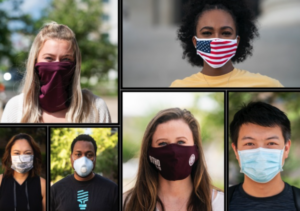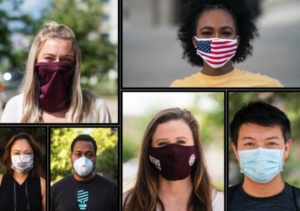“Let my soul smile through my heart
and my heart smile through my eyes,
that I might scatter rich smiles in sad hearts”– Paramahansa Yogananda
It finally happened! I was walking through the market doing some Saturday morning shopping when I came upon an old friend, or so I thought. We nodded to each other and I asked, “How have you been?” “Doing well, and you?” he replied. I shared that I was enjoying time with the Wolfpups, playing golf and writing. I continued, “How is everything with your family and the kids?” He hesitated and said, “The kids are good, but we don’t see them very often. He then asked, “So how long have you had those puppies?” I laughed and responded, “I think we have a case of mistaken identity.” He chuckled while replying, “Damn masks!” We chatted for a few moments, wished each other well and went our separate ways. It seems that in addition to my market items, I gained a new acquaintance.
COVID-19 has changed the way we communicate. Personal space is now social distance, and traditional handshakes, which can be traced back to the 9th century BC, have been replaced with fist and elbow bumps. While face masks are a necessary precaution to prevent the spread of this illness, they have compromised our facial recognition skills. They also hide the parts of our faces that display expressions — particularly those that we use without thinking to convey and perceive sincerity, trustworthiness, and good intentions. When we communicate, our non-verbal messages are often equally, if not more important than the words we use. In fact, in situations where there’s an incongruity between what’s spoken verbally and what’s displayed nonverbally, people instinctively lend greater weight to our non-verbal behavior.
For all intents and purposes, COVID-19 has created a new social etiquette. In essence we are building a new set of norms that include the use of language as a stand-in for the courtesy we would otherwise show nonverbally. It would seem that face masks will be with us for a time to come. Hence, our ability to communicate our ideas effectively while wearing the mask makes this even more important. To this end, Dustin York’s HBR post, How to Build Rapport While Wearing a Mask provides some face mask considerations.
- Select a Mask to Match the Occasion: Who ever thought that in addition to a sock drawer, we would one day have a face mask storage area. There is no shortage of mask designs, colors and themes. Simply put, don’t let your face mask interfere with your message.
- Practice Your Mask Voice – Our voice makes a big difference in how people respond emotionally to what we say. Research has revealed four key elements (PAVE) to making our words more effective:
- Pause: Normally, visual cues of the mouth help us to see when a speaker is pausing for a response. Since we can’t see that now, make a conscious effort to noticeably pause periodically to give people opportunities to jump in or respond.
- Accentuate key phrases and information. Use different intonation.
- Volume – Masks have a slight muffling effect, so speak up.
- Emotion – When appropriate, try to make your voice more expressive by conveying positive emotions like excitement, awe, gratitude, and sympathy.
- Practice Active Listening – When your conversation partner is speaking, show interest by periodically nodding and making sounds of understanding like “Mm hmm.” Affirm understanding or interest with phrases like “I’m listening” or “And then what happened?” Paraphrasing can also be a powerful way to affirm feelings. You can start with a phrase like “So do you mean…” or “What I hear you saying is…” and then say what you think they’re feeling with your own words.
- Use Gestures and Body Language – Make full use of gestures while speaking to convey meaning and emotion. Our hands and shoulders can convey powerful thoughts.
- Use Your Eyes: It has been said that the eyes are, “the window to our soul” They have also been called, “the groin of the face”. When we smile there’s a wrinkling that occurs at the outer edges of your eyes. When we’re wearing masks it is even more important to “smile with your eyes” — or “smize” as model Tyra Banks calls it — if you want to create positive feelings.
COVID-19 and our face masks will be with us for the foreseeable future. While others may not be able to see your smile, your words, non-verbals and actions can send a message of care, compassion and truth. In these challenging times, perhaps there is no greater service we can offer.


